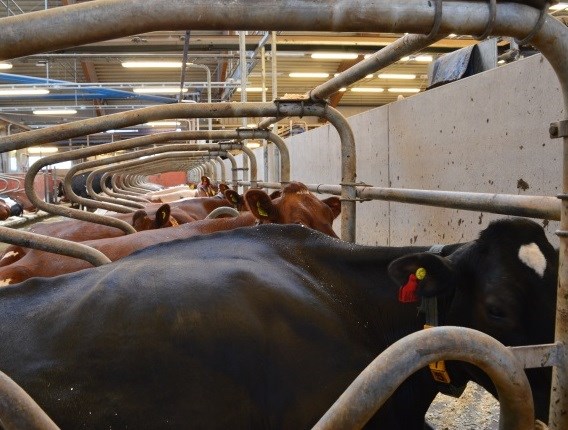Contact
Ambulatory Clinic, Ambulatory Clinic, joint staff
Theodoros Ntallaris
Doctoral Student at the Department of Clinical Sciences; Division of Reproduction
Telephone: 018-671424
E-mail: theodoros.ntallaris@slu.se

This study examined the effect of two feeding levels during the antepartum and postpartum period on reproductive performance and blood metabolites (glucose, non-esterified fatty acids (NEFA), insulin) in primiparous Holstein and Swedish Red (SRB) cows, in order to identify possible differences in the way these breeds respond to negative energy balance after calving.
A total of 44 cows (22 Holstein, 22 SRB) kept in a loose housing system were included in the study. The control group (HE, n = 23) was fed a diet for high-producing cows (target 35 kg/d energycorrected milk, ECM). A lower feeding intensity (LE, n = 21) was achieved by giving -50% concentrate to target 25 kg/d ECM. Diets were implemented 30 days before expected calving and the cows were monitored for 120 days postpartum. Milk yield and composition, dry matter intake (DMI), live body weight and body condition score (BCS) were assessed to calculate the weekly energy balance (residual feed intake). Blood sampling started before diet implementation and was repeated every 2 weeks until Day 60 postpartum and then once monthly until Day 120. Plasma was kept at -20 °C until analysis for glucose, insulin and NEFA concentrations. Mixed linear models were used to analyse data (SAS 9.3; PROC MIXED).
Holstein cows had lower mean energy balance than SRB cows (-4.7 ± 1.4 and -0.9 ± 1.4 MJ, respectively; p = 0.05). SRB cows had higher (p<0.001) BCS (3.3 ± 0.1) than Holstein cows (2.7 ± 0.1) and also higher plasma glucose concentrations from Day -30 to Day 120 relative to parturition (4.1 ± 0.1 and 4.2 ± 0.1 log ; mg/100 ml, respectively; p < 0.05). Overall, breed or diet had no effect on NEFA blood plasma concentrations. However, plasma NEFA concentration levels tended to be higher (p = 0.09) in SRB cows than in Holsteins at Day -14 before calving, indicating higher mobilisation of lipid from adipose tissue already before calving. In contrast, Holstein cows had higher NEFA at Day 14 postpartum than SRB cows (p < 0.05). There were no significant effects of diet or breed on reproductive performance (% pregnant at first AI, days open). However, commencement of luteal activity within 21d postpartum was affected (p < 0.05) by the interaction of breed and diet.
These results suggest that Holstein cows prioritise milk production to a larger extent than SRB cows, resulting in a less balanced metabolic profile.
https://www.ncbi.nlm.nih.gov/pubmed/28166980
T. Ntallaris, P. Humblot, R. Båge, Y. Sjunnesson, J. Dupont, B. Berglund. Effect of energy balance profiles on metabolic and reproductive response in Holstein and Swedish Red cows. Theriogenology. 2017;90:276-83
Theodoros Ntallaris
Doctoral Student at the Department of Clinical Sciences; Division of Reproduction
Telephone: 018-671424
E-mail: theodoros.ntallaris@slu.se